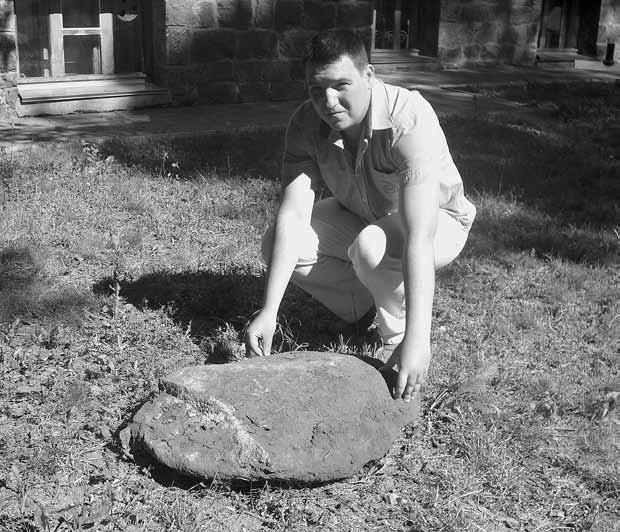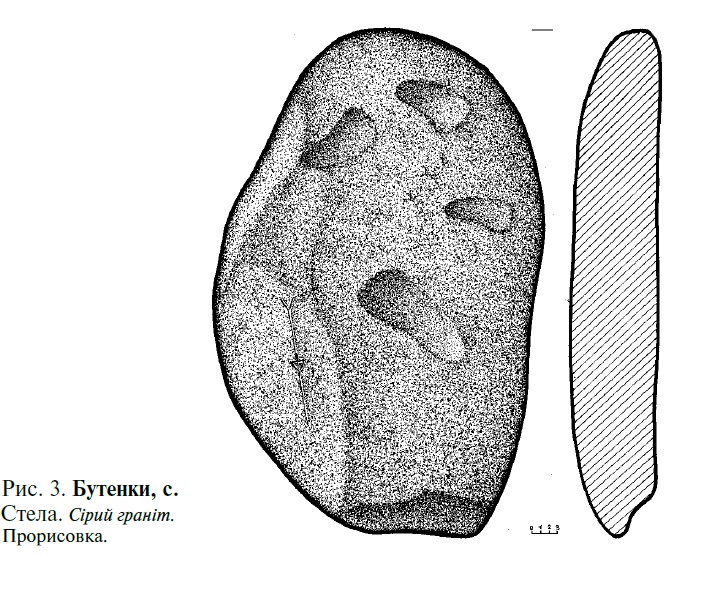
During the reconstruction of the Poltava–Kremenchuk motorway, to the right from Motorway Bridge across the Kobeliachok River, to the north from Butenky village, Kobeliaky district, Poltava region, a stele-shaped stone block was discovered. The remains of a minor kurgan, which was excavated long ago, were also found not far from the uphill right bank terrace.
The stele was made from a flat granite block, similar to oval in its shape. A narrower rounded edge gives it certain anthropomorphic features. The stone for the creation of monument sculpture was taken from the surface deposits of granite along the banks of the Dnipro River (for instance, available in the area of the modern Shmatkivskyi granite quarry close to Karpivka village, Kremenchuk district), 50 km to the south-west from the place where the finding was discovered.
The stele height is 63.5 cm, its width is 39.2 cm, and its thickness is 9.0–11.5 cm. Its weight makes up approximately 60 kg.
Four shallow deepenings that remind the image of feet are observable on weathered surface in the top front part. These forms are well-known in the monumental stone sculpture of the Early Iron Age and among the petroglyph signs of those times. They can be found on numerous stelae, mainly on Fedorivka one from the collection of the Poltava Museum of Local Lore named after Vasyl Krychevskyi and petroglyph signs on Kamiana Mohyla stone slabs.
Such images are considered to be magical, religious or cosmogony nature – the real incarnation (avatar) of the life–giving Sun deity, who walks across the Universe. They are also associated with calendar and ritual symbols. But lately they are mostly considered in the context of one of the principal deities known in Hinduism as Vishnu, “Celestial Archer”, the Protector and the Creator of the Space.
Three major strides of Vishnu as a god in his life – the birth, the creation and the gaining the power over the world – are described in Rigveda. The image of three feet, according to V. M. Danylenko, was related to his strides across the Universe. Sometimes the researchers tend to interpreter the presence of combination 3+1 feet as the understanding of the presence of the universal creator image in the semantics of the same pantheon: Purusha – Ātman – Brahman.
Though, the feet placed in circle correspond with the myth telling how, having heard Indra’s calling from the underworld, Vishnu closed a year’s cycle in the form of “the spinning wheel” and, in the process of creating the world with his three strides, he grew from a dwarf to a giant. Four steps are also associated with the annual cycle – the turnover in nature or the vanishing and re–appearing world in the end of “Brahma’s day”.
The row of images on the front side of the sculpture is also supplemented by one more traced image. It is observable in the right bottom part of the weathered front chamfer. It is a straight vertical traced line 16 cm long, 2-4 mm wide and 2-3 mm deep, that is sligntly splitting to the sides on its top, similar to “Brahman’s club”.
This finding is a bright example of the monumental and sacred sculpture of the Indo-Aryan tribes at the Early Bronze Age within the boundaries of the current Poltava region.
During the reconstruction of the Poltava–Kremenchuk motorway, to the right from Motorway Bridge across the Kobeliachok River, to the north from Butenky village, Kobeliaky district, Poltava region, a stele-shaped stone block was discovered. The remains of a minor kurgan, which was excavated long ago, were also found not far from the uphill right bank terrace.
The stele was made from a flat granite block, similar to oval in its shape. A narrower rounded edge gives it certain anthropomorphic features. The stone for the creation of monument sculpture was taken from the surface deposits of granite along the banks of the Dnipro River (for instance, available in the area of the modern Shmatkivskyi granite quarry close to Karpivka village, Kremenchuk district), 50 km to the south-west from the place where the finding was discovered.
The stele height is 63.5 cm, its width is 39.2 cm, and its thickness is 9.0–11.5 cm. Its weight makes up approximately 60 kg.
Four shallow deepenings that remind the image of feet are observable on weathered surface in the top front part. These forms are well-known in the monumental stone sculpture of the Early Iron Age and among the petroglyph signs of those times. They can be found on numerous stelae, mainly on Fedorivka one from the collection of the Poltava Museum of Local Lore named after Vasyl Krychevskyi and petroglyph signs on Kamiana Mohyla stone slabs.
Such images are considered to be magical, religious or cosmogony nature – the real incarnation (avatar) of the life–giving Sun deity, who walks across the Universe. They are also associated with calendar and ritual symbols. But lately they are mostly considered in the context of one of the principal deities known in Hinduism as Vishnu, “Celestial Archer”, the Protector and the Creator of the Space.
Three major strides of Vishnu as a god in his life – the birth, the creation and the gaining the power over the world – are described in Rigveda. The image of three feet, according to V. M. Danylenko, was related to his strides across the Universe. Sometimes the researchers tend to interpreter the presence of combination 3+1 feet as the understanding of the presence of the universal creator image in the semantics of the same pantheon: Purusha – Ātman – Brahman.
Though, the feet placed in circle correspond with the myth telling how, having heard Indra’s calling from the underworld, Vishnu closed a year’s cycle in the form of “the spinning wheel” and, in the process of creating the world with his three strides, he grew from a dwarf to a giant. Four steps are also associated with the annual cycle – the turnover in nature or the vanishing and re–appearing world in the end of “Brahma’s day”.
The row of images on the front side of the sculpture is also supplemented by one more traced image. It is observable in the right bottom part of the weathered front chamfer. It is a straight vertical traced line 16 cm long, 2-4 mm wide and 2-3 mm deep, that is sligntly splitting to the sides on its top, similar to “Brahman’s club”.
This finding is a bright example of the monumental and sacred sculpture of the Indo-Aryan tribes at the Early Bronze Age within the boundaries of the current Poltava region.
Наукові публікації
Scientific publications
Фотогалерея
Gallery

Стела з під с. Бутенки на подвір'ї Полтавського краєзнавчого музею ім. В. Кричевського.

Бутенки с. Стела. Малюнок.